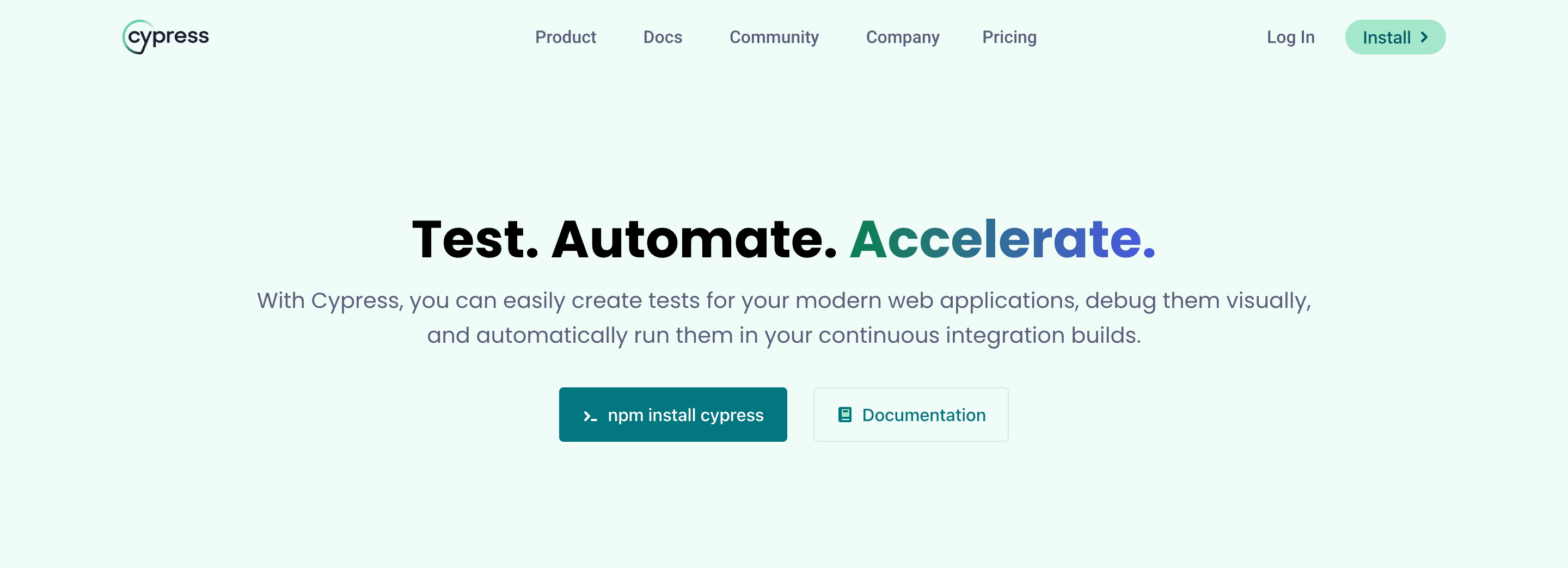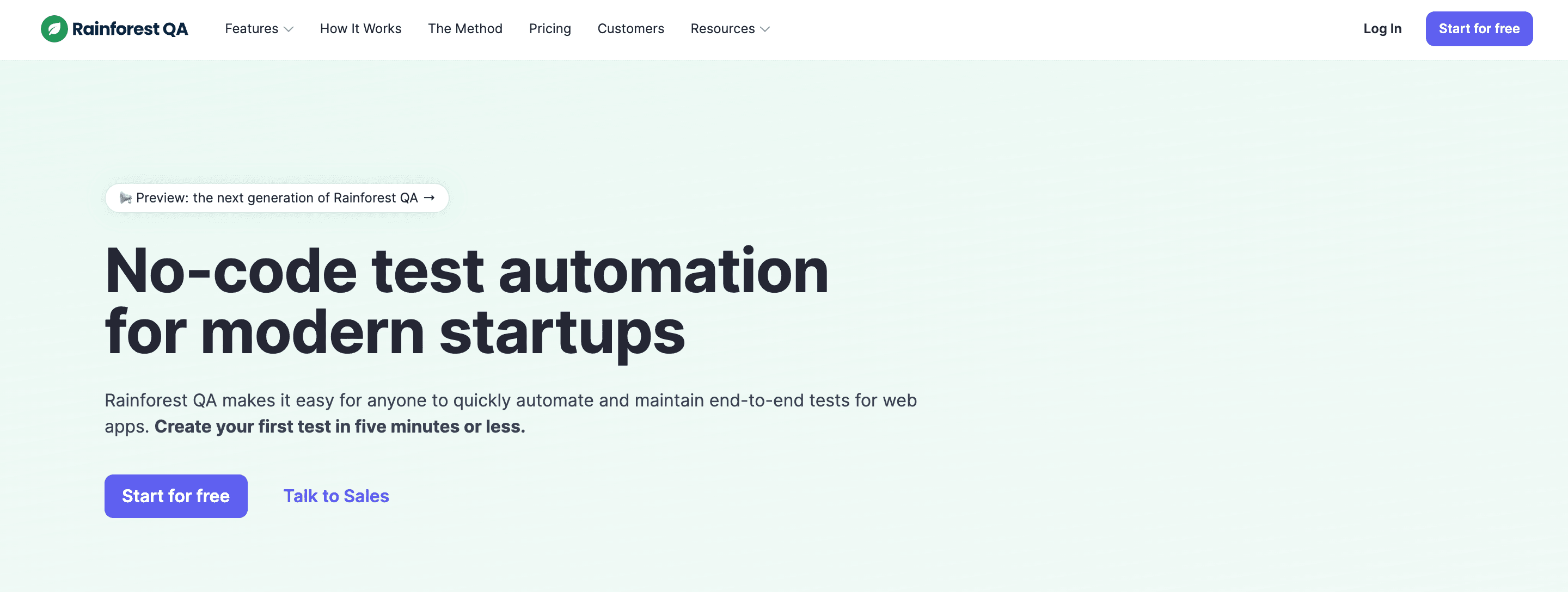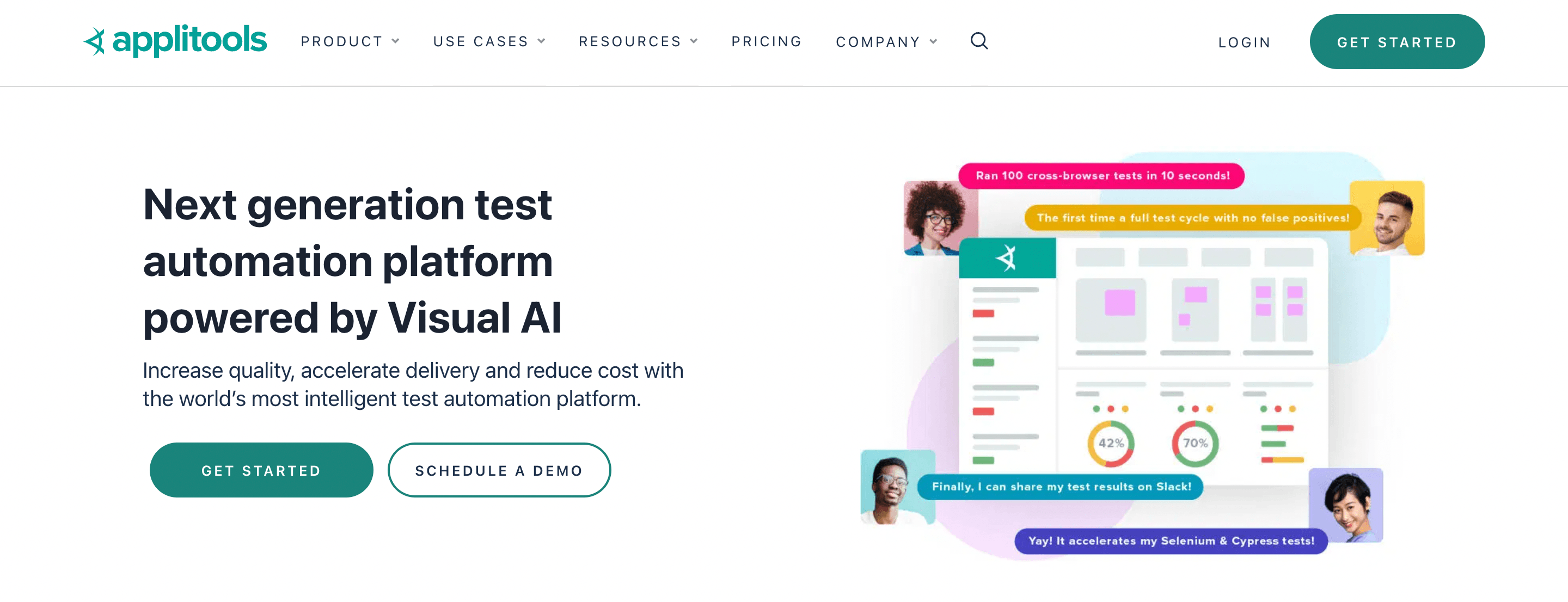- The Challenges with Tools for Automated Front-End Testing
- What Is Front-End Testing?
- Example of Front-End Testing
- Best Practices on How to Create a Front-End Website Testing Plan
- 1. Define Testing Objectives and Goals:
- 2. Identify the Scope of Testing:
- 3. Define Testing Types and Methods:
- 4. Select Testing Tools and End-to-end Frameworks:
- 5. Create Test Cases and Scenarios:
- 6. Establish Test Data and Environments:
- 7. Define Test Execution Schedule:
- 8. Assign Responsibilities:
- 9. Execute Tests:
- 10. Analyze and Report Findings:
- 11. Perform Regression Testing:
- 12. Review and Iterate:
- 13. Document and Maintain:
- Importance of Test Automation
- Front End Testing Frameworks And Tools
- Types of Front End Testing
- Performance Testing
- The Best Front-End Testing Tools in 2023
- Choosing the Right Tool
- Conclusion
- FAQ Section
In the rapidly evolving realm of web development, front-end automation testing tools have become indispensable. These platforms are pivotal in ensuring that the user interface and overall user experience of web applications are efficient, functional, and user-friendly. In this comprehensive guide, we will explore various front-end testing applications, elucidate their utilities, and delve into how they empower web developers and testers to craft seamless online experiences .
Automate your tests for free
Test easier than ever with BugBug test recorder. Faster than coding. Free forever.
Get started
The Challenges with Tools for Automated Front-End Testing
One notable issue with many automation testing platforms is their tendency to prioritize functional testing while neglecting visual testing. While functional testing is critical for ensuring that web applications work as intended, it often leaves gaps in evaluating the visual aspects, potentially leading to a compromised user experience and interface design. Striking a harmonious balance between functional and visual testing has become a pressing concern.
What Is Front-End Testing?
Front-end testing serves as the cornerstone for evaluating the functionality, performance, and usability of web applications from the user's perspective. It encompasses an extensive array of tests and methodologies aimed at guaranteeing that web applications operate seamlessly across diverse browsers, devices, and screen sizes.
Example of Front-End Testing
To gain a deeper understanding of front-end testing, let's examine an illustrative example. Suppose you are developing an e-commerce website, and your goal is to ensure that various components such as the product search bar, shopping cart, and checkout process function seamlessly. Front-end testing entails a variety of tests, including:
- Unit Testing Analyzing individual components like buttons, forms, and navigation menus to ensure their optimal functionality.
- Integration Testing Evaluating how different components collaborate to ensure smooth interactions and data flow.
- End to End Testing Testing the entire user journey, encompassing product selection to completing the purchase, ensuring a seamless experience.
By conducting these tests, front-end testers can pinpoint and rectify potential issues early in the development process, culminating in a more reliable and user-centric web application.
Check also Unit testing vs End-to-end Testing.
Automate your tests for free
Test easier than ever with BugBug test recorder. Faster than coding. Free forever.
Get started
Best Practices on How to Create a Front-End Website Testing Plan
1. Define Testing Objectives and Goals:
Start by clearly defining the objectives and goals of your testing plan. Consider what you want to achieve through front-end testing. Your goals might include ensuring the website functions correctly across different browsers and devices, verifying that the UI is user-friendly, identifying and fixing performance bottlenecks, detecting and addressing security vulnerabilities, and ensuring accessibility for users with disabilities.
2. Identify the Scope of Testing:
Determine the scope of your testing efforts. This includes specifying which parts of the website you will test and what types of tests you will conduct. Common testing scopes include:
- Testing specific pages or sections of the website.
- Verifying the functionality of critical features (e.g., forms, payment processing).
- Assessing visual consistency across different browsers and screen sizes.
- Evaluating performance on key pages or workflows.
- Conducting security assessments, including vulnerability scanning and penetration testing.
3. Define Testing Types and Methods:
Choose the types of tests and testing methods that align with your objectives and scope. Common front-end testing types and methods include:
Unit Testing:
For evaluating individual components or functions within the front end.
Integration Testing:
To ensure that different parts of the website work together seamlessly.
End-to-End (E2E) Testing:
To simulate user interactions and test entire workflows.
Visual Regression Testing:
For detecting unintended visual changes between versions.
Performance Testing:
To assess page load times, server response times, and scalability.
Accessibility Testing:
To ensure compliance with accessibility standards (e.g., WCAG).
Security Testing:
To identify and mitigate vulnerabilities (e.g., cross-site scripting, SQL injection).
API Testing:
To ensure that the UI components (e.g., buttons, forms) properly communicate with the backend services to fetch or submit data.
4. Select Testing Tools and End-to-end Frameworks:
Choose the appropriate testing tools and frameworks based on the types of tests you plan to conduct. Popular front-end testing tools include Selenium, Cypress, Puppeteer, Jest, and Applitools for visual testing. Ensure that the selected tools align with your team's expertise and the technologies used in your web application.
5. Create Test Cases and Scenarios:
Develop detailed test cases and test scenarios for each type of test you plan to perform. Test cases should include:
- Test objectives and expected outcomes.
- Step-by-step test procedures.
- Input data and expected results.
- Precondition and post-condition states.
- Test environment setup and configuration.
6. Establish Test Data and Environments:
Prepare the necessary test data and testing environments. This includes setting up test servers, databases, and configurations that mirror the production environment as closely as possible. Ensure that test data is representative of real-world scenarios.
7. Define Test Execution Schedule:
Create a test execution schedule that outlines when and how often tests will be conducted. Consider running tests at different stages of development, including:
- Unit Testing: During code development.
- Integration and E2E Testing: During integration phases.
- Regression Testing: After code changes or updates.
- Performance Testing: Before deployment to assess scalability.
8. Assign Responsibilities:
Assign specific responsibilities to team members for test preparation, execution, and reporting. Ensure that team members are trained and familiar with the testing tools and methodologies being used.
9. Execute Tests:
Execute the defined test cases and scenarios according to the established schedule. Record test results, including any defects or issues identified during testing. Use test management tools or spreadsheets to track test progress.
10. Analyze and Report Findings:
Analyze test results and prepare comprehensive reports that highlight any issues, defects, or discrepancies found during testing. Prioritize issues based on severity and impact on the user experience.
11. Perform Regression Testing:
After addressing identified issues, conduct regression testing to ensure that fixes did not introduce new problems or regressions. Continuously update and rerun regression tests as development progresses.
12. Review and Iterate:
Review the testing plan and process after each testing cycle. Identify areas for improvement and incorporate feedback into future testing efforts. Iterate on the testing plan to refine and enhance testing practices.
13. Document and Maintain:
Document all test artifacts, including test cases, test data, and test reports. Maintain a record of testing activities and outcomes for future reference and audits.
By following these steps and tailoring your front-end website testing plan to the specific needs of your project, you can ensure that your web application is thoroughly tested, reliable, and ready to provide an exceptional user experience.
Automate your tests for free
Test easier than ever with BugBug test recorder. Faster than coding. Free forever.
Get started
Importance of Test Automation
Test automation is a software testing technique that involves using automated tools and scripts to perform tests on software applications. It aims to streamline and accelerate the testing process by automating repetitive and manual test cases.
Test automation can improve test coverage, reduce human errors, and provide faster feedback to developers, making it an essential practice in modern software development. However, it requires initial investment in creating and maintaining test scripts and infrastructure.
Automate your tests for free
Test easier than ever with BugBug test recorder. Faster than coding. Free forever.
Get started
Front End Testing Frameworks And Tools
The question of whether front-end testing should be automated ultimately comes down to project goals, resources, and specific testing requirements. Automated front-end testing offers undeniable advantages in terms of efficiency, accuracy, and scalability. It empowers development teams to detect and address issues early, deliver high-quality applications, and meet the demands of modern development practices.
However, automation is not a one-size-fits-all solution. Some scenarios may be better suited for manual testing, particularly those involving subjective evaluations, usability assessments, and exploratory testing.
In practice, many development teams adopt a hybrid approach, combining automated testing for repetitive and well-defined scenarios with manual testing for areas requiring human judgment and creativity. This approach allows organizations to leverage the strengths of both automation and manual testing, ultimately ensuring the delivery of robust, user-friendly, and visually appealing applications.
Advantages of Automated Front-End Testing:
- Efficiency: Automated tests can be executed repeatedly and swiftly, conserving time and effort when compared to manual testing.
- Precision: Automated tests adhere to predefined scripts, minimizing the likelihood of human errors during testing.
- Swiftness: Automated tests can run concurrently, enabling prompt feedback and swift identification of bugs.
Automate your tests for free
Test easier than ever with BugBug test recorder. Faster than coding. Free forever.
Get started
Types of Front End Testing
Unit Testing
Unit testing focuses on evaluating individual components within a website. Popular tools like Jest and Mocha simplify this process.
Visual Regression Testing
This testing ensures UI consistency using tools like BackstopJS and Percy.
Integration Testing
Evaluation of component interactions can be done using the same frameworks as unit testing or specialized integration testing tools.
End-to-End Testing (E2E Testing)
E2E Testing involves testing user workflows and is done effectively using BugBug, Cypress, Selenium, and Puppeteer.
Performance Testing
Evaluation of application speed and stability is done using tools like Apache JMeter, Google PageSpeed Insights, and WebPageTest.
Cross-Browser Testing
Ensuring compatibility across browsers, using platforms like BrowserStack and Sauce Labs.
Acceptance Testing
Evaluates if the application meets user and business requirements. Tool choice depends on the development stack and language.
UI/UX Testing
Focuses on the application’s user interface and experience. Often involves manual human testing.
Check more on UI Automation Tools.
Automate your tests for free
Test easier than ever with BugBug test recorder. Faster than coding. Free forever.
Get started
Performance Testing
1. Load Testing
Evaluates application performance under heavy traffic using tools like Apache JMeter and Gatling.
2. Speed Testing
Focuses on web page loading times. Tools like Google PageSpeed Insights and WebPageTest are popular.
3. Stress Testing
Uncovers potential failures under extreme conditions to ensure application resilience and dependability.
4. Scalability Testing
Assesses the application's ability to scale with increased user loads and ensures seamless expansion capabilities.
The Best Front-End Testing Tools in 2023
1. BugBug

BugBug is a test automation tool, meticulously crafted to assist quality assurance professionals, testers, developers, and product managers in efficiently recording, executing, diagnosing, and overseeing tests for websites and web applications.
Key Features:
- Remarkably user-friendly UI
- Support for parallel test execution
- Intelligent automation of scrolling and waiting for page loading
- Seamless integration with any Continuous Integration/Continuous Delivery (CI/CD) pipeline
- Support for both local and cloud-based test runs
- Parallel testing capabilities
- Unlimited number of test runs and users for free
You can sign up your business within a few minutes and begin web testing after installing the Chrome extension. After registering you have a 14-day trial period for Pro plan
Automate your tests for free
Test easier than ever with BugBug test recorder. Faster than coding. Free forever.
Get started
2. Selenium

Selenium stands as a renowned and open-source test automation framework that has endured the test of time. It provides a versatile platform for automating web apps across diverse browsers and platforms. Selenium boasts support for multiple programming languages, including Java, Python, and JavaScript, rendering it accessible to a broad spectrum of developers.
Key Features:
- Cross-browser compatibility testing
- Support for parallel test execution
- Extensive browser compatibility (Chrome, Firefox, Safari, etc.)
- Seamless integration with frameworks like TestNG and JUnit
- Thriving and active community support
Selenium's flexibility and robust capabilities continue to make it a favored choice for web developers and testers in 2023. Its capacity to execute automated tests across a plethora of browsers ensures that web apps are compatible and functional in various environments.
3. Cypress

Cypress has emerged as a prominent player in the realm of front-end testing due to its user-friendly interface and features that streamline the process. It is a test automation tool and framework that is engineered to empower developers and testers with the ability to write end-to-end tests with simplicity and precision.
Key Features:
- Real-time interactive testing
- Automatic waiting for elements to become available
- Time-travel debugging
- Accessible and intuitive API for writing tests
- Seamless integration with popular CI/CD pipelines
Cypress's commitment to a seamless and productive testing experience has garnered it a dedicated following among web development teams in 2023.
4. Rainforest QA

Rainforest QA is a comprehensive front-end testing solution that has gained prominence for its extensive features catering to diverse front-end testing needs. It provides a platform that combines automated and manual testing capabilities, offering flexibility and precision to testing teams.
Key Features:
- Test case management
- Crowdtesting with a global community of testers
- Integration with popular testing tools and frameworks
- AI-powered test execution
- Real-time reporting and analytics
Rainforest's holistic approach to front-end testing, encompassing both automation and crowdtesting, empowers organizations to attain meticulous and real-world testing coverage. The integration with AI-driven processes positions it as a valuable asset for achieving testing efficiency and accuracy in 2023.
5. TestComplete

TestComplete is a robust and comprehensive test automation tool that caters to both desktop and web apps. It equips testers and developers with a unified platform for creating, executing, and managing automated tests, streamlining the process.
Key Features:
- Cross-platform testing (Windows, web, mobile)
- Codeless and script-based test creation
- Distributed testing for scalability
- Integration with popular CI/CD pipelines
- Comprehensive test reporting and analysis
TestComplete's versatility and cross-platform capabilities make it a versatile choice for organizations in 2023, particularly those dealing with a mix of web and desktop applications.
6. Applitools

Applitools distinguishes itself by revolutionizing visual testing with AI-powered functionalities. It offers a visual AI testing platform that allows testers to automate visual validations and effortlessly detect visual discrepancies in web applications.
Key Features:
- Visual AI technology for automated visual testing
- Cross-browser and cross-device testing
- Integration with popular frameworks and CI/CD pipelines
- Intelligent visual validation that detects visual bugs
- Root cause analysis for quick issue resolution
Applitools's innovative approach to visual testing, driven by AI technology, sets it apart as a trailblazer in the field. In 2023, where visual consistency is paramount, Applitools empowers organizations to deliver pixel-perfect user interfaces across diverse environments.
Automate your tests for free
Test easier than ever with BugBug test recorder. Faster than coding. Free forever.
Get started
Choosing the Right Tool
Consider your team's skills, the tool's features, compatibility, ease of use, integration, support, scalability, and reporting capabilities. Evaluate budget constraints and consider trying tools like BugBug.io and SikuliX for free.
Conclusion
Balancing automation and manual testing, choosing appropriate tools, and following best practices are essential in ensuring quality, functionality, and excellent user experience in web applications.
FAQ Section
What is Front End Testing?
It involves evaluating visual and functional elements of web applications to ensure optimal performance and user experience.
How Important are Front End Testing Frameworks and Tools?
They are vital for automating repetitive tasks, providing accurate results, enhancing user experience, and improving web application performance.
Which Front End Tool is Best for Performance Testing?
Selection depends on testing requirements, budget, team expertise, and scalability needs. Tools should be chosen based on project-specific needs and requirements.
Happy (automated) testing!



